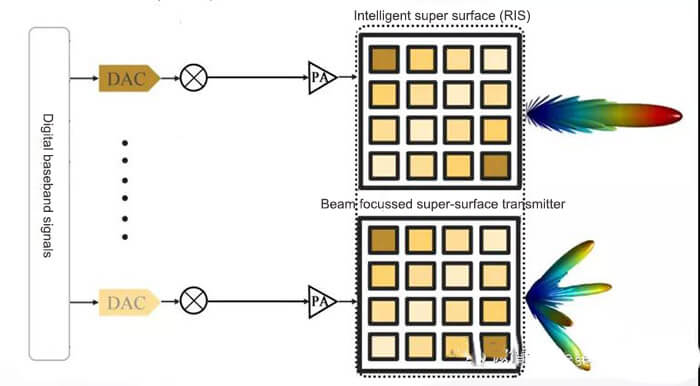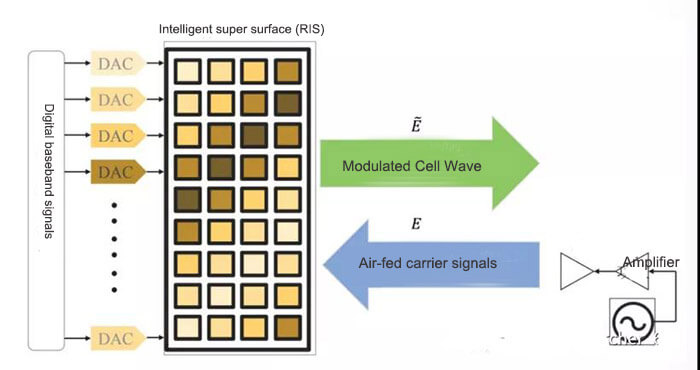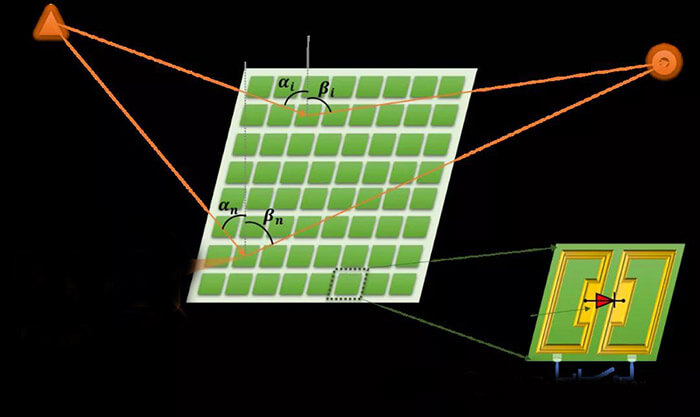Intelligent super surface wiki
An intelligent super surface (RIS) is an artificial electromagnetic surface structure with programmable electromagnetic properties, developed from metamaterials technology.
An intelligent super surface (RIS) typically consists of a large number of carefully designed arrangements of electromagnetic cells.
The electromagnetic properties of these cells can be dynamically controlled by applying control signals to the tunable elements on the cells, thereby enabling active and intelligent modulation of space electromagnetic waves in a programmable manner to form electromagnetic fields with controllable amplitude, phase, polarization, and frequency.
Typical applications include solving the coverage hole problem in wireless communications, extending coverage, suppressing electromagnetic interference, improving transmission freedom, and achieving high-accuracy sensing and positioning, as well as being used in beam-fitting super-surface transmitters and implementing new types of information-modulated super-surface transmitters.
By building an intelligent and controllable wireless environment, intelligent super surface (RIS) will bring a new communication network paradigm to the future 6G and meet future mobile communication needs.
Underlying principles of intelligent super surface (RIS)
Proposed by Soviet physicist Veselago in 1968, the concept of metamaterials is a class of materials that have artificially designed structures and exhibit extraordinary physical properties that natural materials do not possess.
Early three-dimensional metamaterials suffered from structural complexity, high dielectric losses, and difficulties in preparation, so an ultra-thin, two-dimensional form of metamaterial was created.
It consists of cells arranged closely in a plane, and the electromagnetic waves are tuned by changing the electromagnetic structure or the way the cells are arranged.
The introduction of tunable components into the super-surface structure constitutes a Reconfigurable Intelligent Surface (RIS), where the electromagnetic properties of the super-surface can be changed in real-time by controlling the tunable components to regulate the electromagnetic parameters of the reflected electromagnetic waves, such as phase, frequency, and amplitude.
Currently, intelligent super surface (RIS) devices consist of large-scale device arrays and array control modules.
A large-scale device array is a large number of device units arranged in a regular repetitive pattern on a flat base plate. To achieve significant signal manipulation, arrays of several hundred or several thousand device cells are usually required.
Each device cell has a variable device structure, e.g. the device cell contains a PIN diode, the switching state of which determines the response pattern of the device cell to external radio signals.
The array control module of the RIS controls the operating state of each device cell and thus dynamically or semi-statically controls the response pattern of each device cell to the wireless signal.
The wireless response signals from each device cell of a large-scale device array are superimposed on each other to form a specific beam propagation signature at a macro level. The control module is the brain of the intelligent super surface (RIS) device, determining the wireless signal response beam of the intelligent surface according to the needs of the communication system, making the original static communication environment intelligent and controllable.
Intelligent super surface (RIS) applications in 6G systems
The emergence of intelligent super surface (RIS) technology has brought about the emerging concept of an “intelligent wireless environment”. In traditional wireless networks, the environment is not fully controlled by the operator.
In contrast, in an intelligent wireless environment, the environment is transformed into an intelligently reconfigurable space that plays an active role in information transmission and processing.
The outlook for future intelligent super surface (RIS) application scenarios falls into two main categories, one being intelligent super surface (RIS) wireless relay applications in the form of reflective surfaces and the other being RIS-based large-scale antenna transceiver applications.
RIS-based wireless relay applications
Signal coverage supplementation and extension:
The intelligent super surface (RIS) can be deployed between base stations and coverage blind areas, base stations, and edge users or weak coverage areas, enabling the transmission signal to enhance blind area coverage and improve signal quality for edge users through effective reflection.
RIS can also be deployed on glass surfaces of buildings or indoors to effectively receive signals transmitted by the base station and transmit/reflect them indoors to improve indoor signal quality.
Using this feature, intelligent super surface (RIS) can be used to assist with airway coverage by reflecting signals from ground-based base stations onto the airways of UAVs (Unmanned Aerial Vehicles), promising a wide range of airway signal coverage.
RIS can also be deployed on UAV fuselages to take advantage of the flexibility of UAVs to provide excellent line-of-sight communication links in hotspots, disaster areas, or coverage blind spots, enabling rapid deployment.
The RIS-based telematics system can enhance the effective communication distance of vehicles while reducing the coverage of blind areas of telematics, providing new solutions and feasible methods for the development of telematics.
Cell-edge rate enhancement and interference suppression
By deploying intelligent super surface (RIS) at suitable locations, the useful signal can be accurately transmitted to the target user’s area through beam assignment, which can effectively suppress the interference to neighboring cells while increasing the received power of the useful signal.
In addition, the uplink channel of users at the edge of the cell will become a bottleneck for service transmission due to the limited transmission power of users. Deploying intelligent super surface (RIS) at suitable locations to enhance the received signal strength and suppress interference at the base station side can effectively improve the uplink rate of terminals.
Using signal focusing and interference suppression, intelligent super surface (RIS) can also be used to achieve secure communications, reduce electromagnetic pollution, and energy harvesting and transmission.
Hotspot multi-stream and line-of-sight multi-stream transmission: The introduction of intelligent super surface (RIS)-based controllable channels in line-of-sight transmission scenarios will improve the spatial correlation of the channels between the transceiver antenna arrays and increase the number of characteristic channels for data transmission.
This will enable higher SPDM gain and improve the transmission performance of the system and users, thus supporting multi-stream and multi-user transmission scenarios in line-of-sight scenarios and more new 6G services.
Transmission robustness enhancement
The intelligent super surface (RIS) has a large number of passive reflective elements, which are capable of generating multiple reflective beams through grouped or distributed deployment of passive elements. The transmission robustness of the system can be enhanced through multi-beam transmission.
High accuracy positioning
While traditional cellular networks provide wireless positioning capabilities where positioning accuracy is limited by the limited base station deployment location and the number of positioning base stations, intelligent super surface (RIS) can be flexibly deployed inside the base station service area to assist the base stations in positioning.
Compared to traditional multi-base station positioning, intelligent super surface (RIS) is expected to achieve higher positioning accuracy due to its ability to have a finer beam and better spatial resolution on the one hand, and better positioning signal quality due to its proximity to the user’s location on the other.
RIS-based wireless relays have the following advantages over conventional relays.
(1) Low power consumption and high energy efficiency
Intelligent super surface (RIS) is expected to achieve low power consumption and high energy efficiency as it does not require amplifiers, feeders, etc., except for active devices such as controllers and FPGAs.
(2) Ease of deployment
In addition to the thinness and low weight of intelligent super surface (RIS) devices, the low power consumption of intelligent super surface (RIS) makes it possible to achieve connections that do not require wired power, which can reduce the complexity of siting and deployment.
(3) Low hardware cost
Intelligent super surface (RIS) eliminates the need for complex RF and baseband processing circuitry and hardware costs can be lower.
(4) Low thermal noise
Intelligent super surface (RIS) usually does not require amplifiers, downconversion, etc. to process the received signal, but only to change the direction of the signal, so the thermal noise is low.
Large-scale intelligent super surface (RIS)-based antenna transmitter applications
Based on the fact that intelligent super surface (RIS) can effectively modulate the wavefront and various electromagnetic parameters of an electromagnetic signal without the need for complex RF transceiver operations, two main types of RIS-based large-scale antenna transmitter applications have been proposed, one is a beam-functional super-surface transmitter and the other is an information-modulated super-surface transmitter.
Both of these new transmitter architectures emit electromagnetic waves to the super-surface via a feed source and emit electromagnetic signals via intelligent super surface (RIS) reflection/transmission.
The difference is that in the beam-focused super-surface transmitter, the intelligent super surface (RIS) is equivalent to a phased-array antenna, where the baseband signal processing is performed first, followed by the RF signal output from the RF chain, which is reflected/transmitted by the intelligent super surface (RIS) to achieve beam-focused electromagnetic waves.

Figure 1 intelligent super surface (RIS)-based large-scale antenna transmitter – beam focussed super-surface transmitter

Figure 2 intelligent super surface (RIS)-based Large Scale Antenna Transmitter – Information Modulated Supersurface Transmitter
The Information Modulated Super surface Transmitter replaces a large and complex RF link with a programmable metamaterial and its accompanying control circuitry and a signal source providing the RF segment carrier.
The amplitude, phase, polarization, and frequency of the air-fed carrier signal can be programmed in real time by dynamically controlling the electromagnetic parameters of the RIS electromagnetic units by applying control signals to the adjustable elements of these units.
For example, the “0” and “1” digital states are electrically regulated by controlling the on/off switching diodes in the electromagnetic unit, and the phase distribution of the incident electromagnetic wave is regulated in real time by using an FPGA hardware system to input the code to the digital super-surface. The final reflected/transmitted carrier signal on the intelligent super surface (RIS) generates a tuned signal carrying the baseband signal.
Compared to conventional large-scale antenna transmitters, information-modulated super-surface transmitters do not require complex baseband processing and signal transmission operations to modulate the signal from baseband to RF, and they not only artificially improve the wireless channel but also make use of programmable metamaterials to replace, to some extent, the analog components in the conventional RF chain.
The analog RF part of a conventional wireless communication system is responsible for signal up- and down-conversion, carrier signal modulation, and power control, which contains many analog devices such as mixers, filters, power amplifiers, etc. Not only is the system structure complex and costly to design and manufacture but there are also unpredictable human or hardware errors.
Information-modulated super-surface transmitters, as the associated harmonic modulation and filtering are implemented on the RIS, do not require mixers and RF filters, and have low RF amplifier bandwidth performance requirements, requiring only a narrowband power amplifier to amplify the power of the air-fed single-tone carrier signal.
Therefore, this new transmitter architecture reduces the overall structural complexity and design and manufacturing cost, potentially reduces the power loss of the system, and improves the energy efficiency, which, together with the ability to modulate the amplitude and phase of the electromagnetic wave, makes it a promising alternative to conventional RF links.
Intelligent super surface (RIS) research status at home and abroad
Intelligent super-surface can flexibly adjust the signal beam in the wireless environment according to the user distribution, significantly improving the signal strength, network capacity, and user rate in weak coverage areas of existing networks.
China has developed a prototype intelligent super surface (RIS) prototype in the 5.8GHz band, achieving a power gain of 26~27dB and a long-range (500m) signal transmission at a rate of 32Mbps at a transmit power of 23dBm, verifying the feasibility of RIS for future wireless communications.
DOCOMO Japan tested 28 GHz millimeter-wave communication based on static RIS equipment for the first time in 2019 in an external field, by transmitting signals from a 37.4m high base station antenna, incident at 50° to a RIS panel with a height of 3.4m and dimensions of 80cm*80cm, and then reflected at 30°, its communication rate increased from 60Mb/s without RIS to 560Mb/s.
The Massachusetts Institute of Technology has also built RFocus, a testbed operating in the 2.4GHz unlicensed band, to verify the feasibility of deploying intelligent super surface (RIS) in indoor mall scenarios, with an average increase of about two times in indoor signal coverage strength.
In terms of RIS-based large-scale antenna transceivers, domestic universities have designed RIS-based communication systems and provided unique insights on the construction design and system architecture of RIS device units.
In 2019, Tsinghua University designed and built a beam-functional super-surface transceiver and conducted performance tests in the low-frequency band (2.3GHz) and millimeter-wave band (28.5GHz) respectively, which showed that the low-frequency band wireless communication platform could achieve a transmission rate of 28Mbps and the millimeter-wave band wireless communication platform could achieve a transmission rate of 1.6836Gbps, thus verifying the feasibility and effectiveness of RIS in future wireless communication systems.
In 2020, Professor Timothy O’Farrell’s team at the University of Sheffield in the UK implemented single-stream phase-modulated transmission using RIS direct modulators and performed relevant tests in an end-to-end communication system.
Intelligent super surface (RIS) technical challenges and development directions
In recent years, despite the rich progress and achievements of academic and industry research on intelligent super surface (RIS) technology, it will still face technical and cost challenges from multiple aspects and levels before it is commercially available on a large scale.
From the perspective of hardware maturity, there are challenges in terms of adjustable device performance to meet the modulation requirements, structure, and modulation mechanism to be optimized.
From the perspective of channel modeling, there are challenges of imperfect channel models and high complexity of channel modeling and measurement.
From the perspective of performance analysis and scheme design, there are challenges such as performance evaluation is not yet comprehensive and the lack of a complete transmission theory basis.
From a network architecture and control perspective, there is a lack of definition and solution discussion on RIS relay node functions, RIS transceiver transmission protocols, and control methods for both of the above.
From a deployment perspective, there are issues such as the need to communicate with property owners and landlords to access the site, the need for a power supply to control the intelligent super surface (RIS) panels, and for larger intelligent super surface (RIS) areas, there are also issues such as high wind resistance and maintenance difficulties.
Besides the What is an Intelligent Super Surface (RIS) article, you may also be interested in the below articles.
What Is The Core 5G NR Technology?




